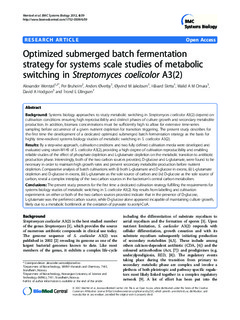Optimized submerged batch fermentation strategy for systems scale studies of metabolic switching in Streptomyces coelicolor A3(2)
Wentzel, Alexander; Bruheim, Per; Øverby, Anders; Jakobsen, Øyvind Mejdell; Sletta, Håvard; Omara, Walid A.M.; Hodgson, David A.; Ellingsen, Trond Erling
Journal article, Peer reviewed
Permanent lenke
http://hdl.handle.net/11250/2358358Utgivelsesdato
2012Metadata
Vis full innførselSamlinger
Sammendrag
Background: Systems biology approaches to study metabolic switching in Streptomyces coelicolor A3(2) depend on
cultivation conditions ensuring high reproducibility and distinct phases of culture growth and secondary metabolite
production. In addition, biomass concentrations must be sufficiently high to allow for extensive time-series
sampling before occurrence of a given nutrient depletion for transition triggering. The present study describes for
the first time the development of a dedicated optimized submerged batch fermentation strategy as the basis for
highly time-resolved systems biology studies of metabolic switching in S. coelicolor A3(2).
Results: By a step-wise approach, cultivation conditions and two fully defined cultivation media were developed and
evaluated using strain M145 of S. coelicolor A3(2), providing a high degree of cultivation reproducibility and enabling
reliable studies of the effect of phosphate depletion and L-glutamate depletion on the metabolic transition to antibiotic
production phase. Interestingly, both of the two carbon sources provided, D-glucose and L-glutamate, were found to be
necessary in order to maintain high growth rates and prevent secondary metabolite production before nutrient
depletion. Comparative analysis of batch cultivations with (i) both L-glutamate and D-glucose in excess, (ii) L-glutamate
depletion and D-glucose in excess, (iii) L-glutamate as the sole source of carbon and (iv) D-glucose as the sole source of
carbon, reveal a complex interplay of the two carbon sources in the bacterium's central carbon metabolism.
Conclusions: The present study presents for the first time a dedicated cultivation strategy fulfilling the requirements for
systems biology studies of metabolic switching in S. coelicolor A3(2). Key results from labelling and cultivation
experiments on either or both of the two carbon sources provided indicate that in the presence of D-glucose,
L-glutamate was the preferred carbon source, while D-glucose alone appeared incapable of maintaining culture growth,
likely due to a metabolic bottleneck at the oxidation of pyruvate to acetyl-CoA.
